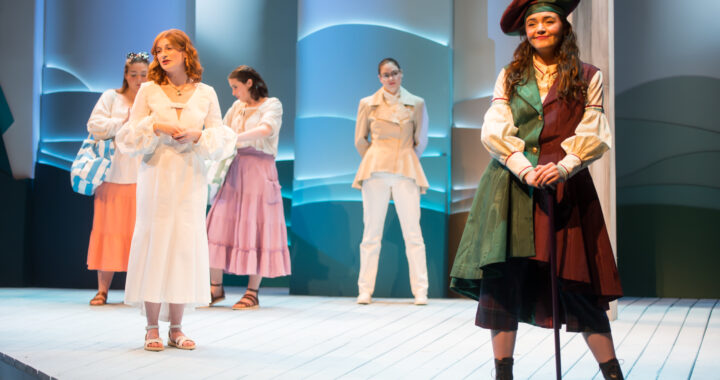Michael Benson joins theatre department as set designer
5 min read
Aaron Reynolds | The Blue & Gray Press
By LINDSEY BROWN
Senior Writer
Michael Benson grew up in the theatre and has been going to shows since he was three years old. His father was a high school English teacher that also directed the musicals at his high school. One of Benson’s earliest memories is when he saw one of his father’s productions, “Fiddler on the Roof.” He remembers being terrified by the character Fruma-Sarah.
“She came in from the back of the auditorium and I wasn’t expecting that. My mom had to take me out; I was crying. My dad took me back to meet her afterwards. It didn’t matter, she was still in all her make-up, I wanted no part of it.”
Theatre became something he shared with his father, and they did it together. When Benson’s father passed when he was 16, he almost gave it up.
This is Benson’s first year at UMW as an assistant professor and designer. Benson moved here from Missouri where he was Assistant Professor of Scene Design and Technology at the University of Central Missouri. Benson chose to come to UMW because the program that he attended as an undergraduate was very similar to the program at UMW.
“The theatre program is the same. Everybody is in everybody’s cups, which is a good thing and a bad thing at the same time. But it’s something you would never want to change. Boy, it’s just a great place. Why wouldn’t I want to come here?”
When asked how he feels about the transition of coming to UMW, Benson said, “It’s kind of been akin to merging onto a fast-moving highway. You don’t want to stutter. You don’t want to stop. You don’t want people honking at you at the same time. It’s getting there. I have some great colleagues that are helping me through.”
Benson designed “Little Shop of Horrors” this past winter. He worked mainly on the sets but also worked with guest designers Jason Arnold on light design and Tony Angelini on sound design. Benson’s first focus is the text when working on a show. The music in a musical brings out the emotion that is sometimes lost in plays. He also focused on whose story the musical is based on.
In “Little Shop of Horrors,” it is Seymour’s story. Benson made the sets tall and dingy with a comic book feel. He focused on bright colors in the set, but dirtied them up to add to the doomed feeling in the show. The giant plant dictated what could and couldn’t be done in designing the show as well.
“In a musical when you have the music you can listen to, or a recording of a song, it adds some emotional content or direction that otherwise might be lacking. I wanted the world to feel tight and oppressive.”
Benson does not have a favorite show he looks back on and declares his favorite. He feels that whatever show he is working on at the time is his favorite. “Part of that is growth as an artist. As a designer you have to constantly be looking for new ways to say things. So currently my favorite show is “Medea.”
Benson explained that the show he is working on now, “Medea” takes well to concept. It works well with concept because the play is over two-thousand years old, and it has themes that are still relevant today. This makes it easier for contemporary audiences to enjoy and relate the the story. Working with the director Helen Housley, Benson says she has very complex ideas about the contemporary part of the show. The focus for this show is Post-Modernism, and his research involved contemporary architects. The Polish architect Daniel Libeskind was a source of inspiration for the design in this show. The setting is meant to evoke to the audience how Medea feels as a stranger in a strange land.
“We wanted the set to reflect the power of the family. We wanted it to feel off-kilter, slightly oppressive and cold,”said Benson. “This has been an exciting one to do. When I was hired, and I saw the season, I hoped I would be able to design “Medea.” The Greek plays have always had a special place for me.”
Benson went to Baldwin Wallace College outside of Cleveland for music education, but soon learned he had to be a part of theatre somehow. He studied acting at the Lee Strasberg Institute in New York City. He finished at Baldwin Wallace College with dual degrees in music and theatre. He worked as an actor, until “I found out I really liked things like shelter and food,” joked Benson. He knew he had to do something else to stay afloat.
Benson’s roommate was the first hand at the Cleveland Opera and he would occasionally lend a hand with unloading trucks for sets. Benson was eventually hired to help make modifications to the sets. He soon learned that carpentry was something that came very easily to him. Meanwhile, he worked as a sound designer around town in Cleveland.
Benson moved around quite a bit working as a technical director, stage technician and sound technician. He has worked all over the US, the only place he hasn’t worked is the Pacific Northwest. In North Carolina, he owned his own scenery construction business. At 35, he realized he wanted to be a better designer, so he got his master’s degree at Penn State.
“I came into design late. It’s one of the last things I stumbled into. It was a lot of fun [working at Pittsburgh Musical Theatre]. But I realized early on, looking at the work I wanted to make it better. I had my choice of deciding whether I wanted to study technical theatre or design. I decided to study design because it was an area I wanted to learn more about.”
Benson also brings something new to the UMW theatre department, and that is computer aided design. It is a software that allows you to three dimensionally model the scenery and theatre space. It allows you to add textures and theatrical lightning. Benson explains, “the 3D model can be used in a variety of ways. It is easier to general working drawings for the shop for construction. It’s helpful to other designers in their design process as well. We can even use the virtual model to 3D print a physical scale model for display.”
Benson’s colleague and fellow professor Julie Hodge, who has been working for UMW for 30 years feels Benson has been a great asset to the theatre department.
“He has this tremendous excited energy and our students are picking up on it and love it. We just really enjoy having him here with us. He brings new talents to our department, like computer aided design, which is really exciting for us. Where I’m old school, he’s new school.”
When asked his favorite part about this job, Benson said, “The students, always the students.”
His next show, “Medea,” will run from Apr. 12 to 22.











